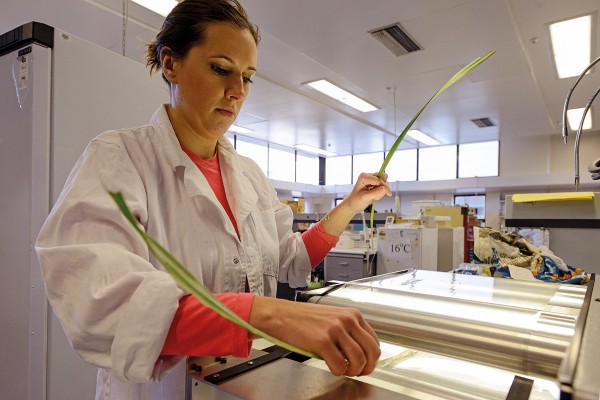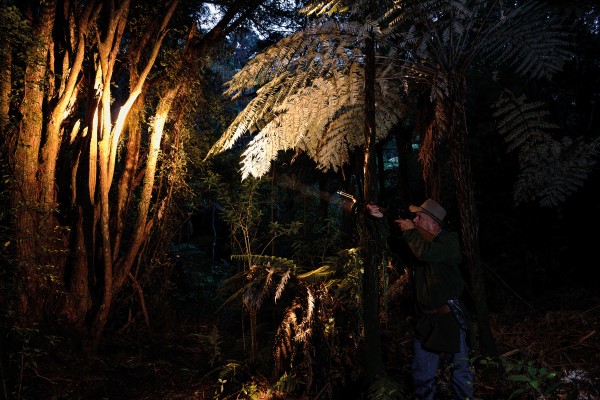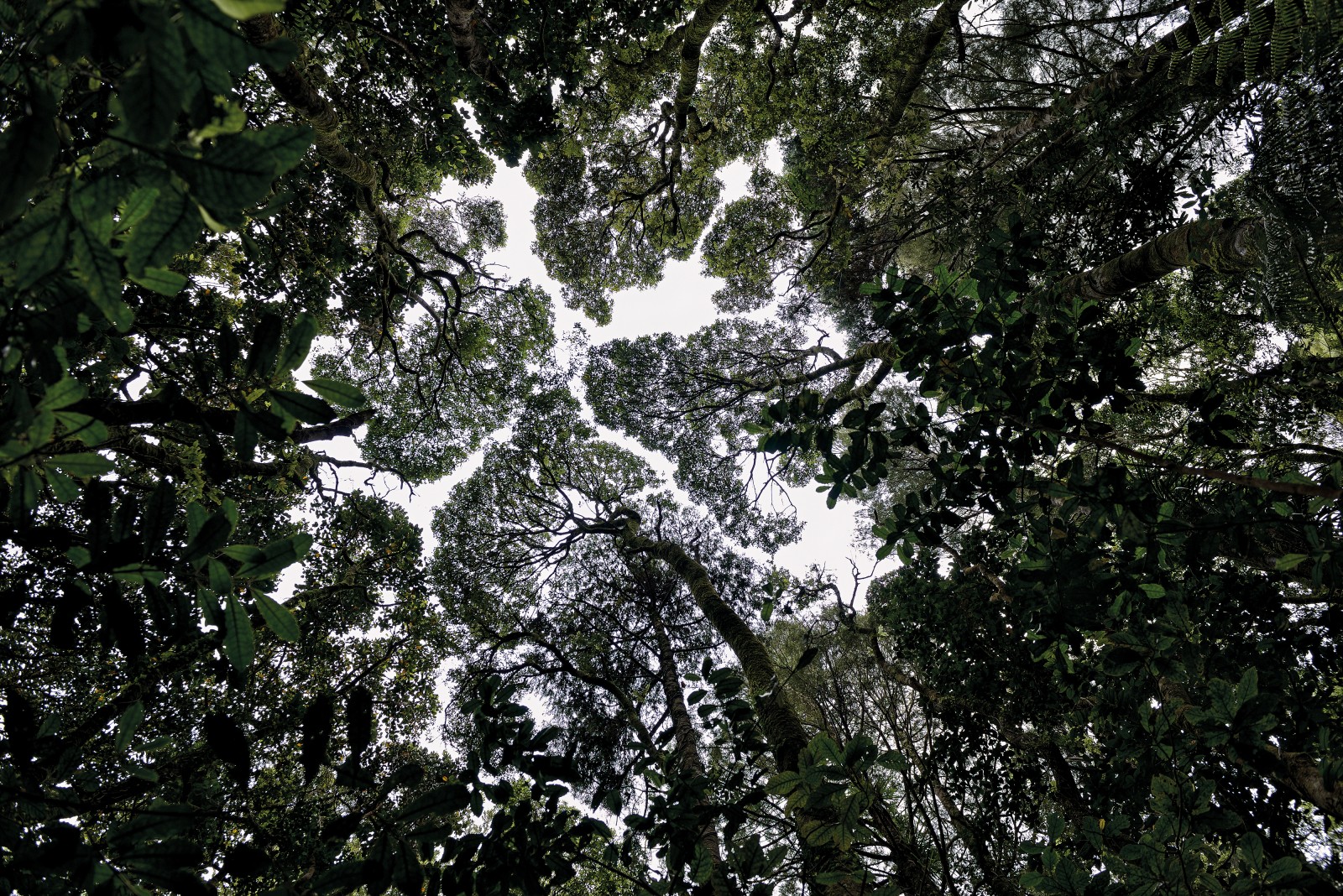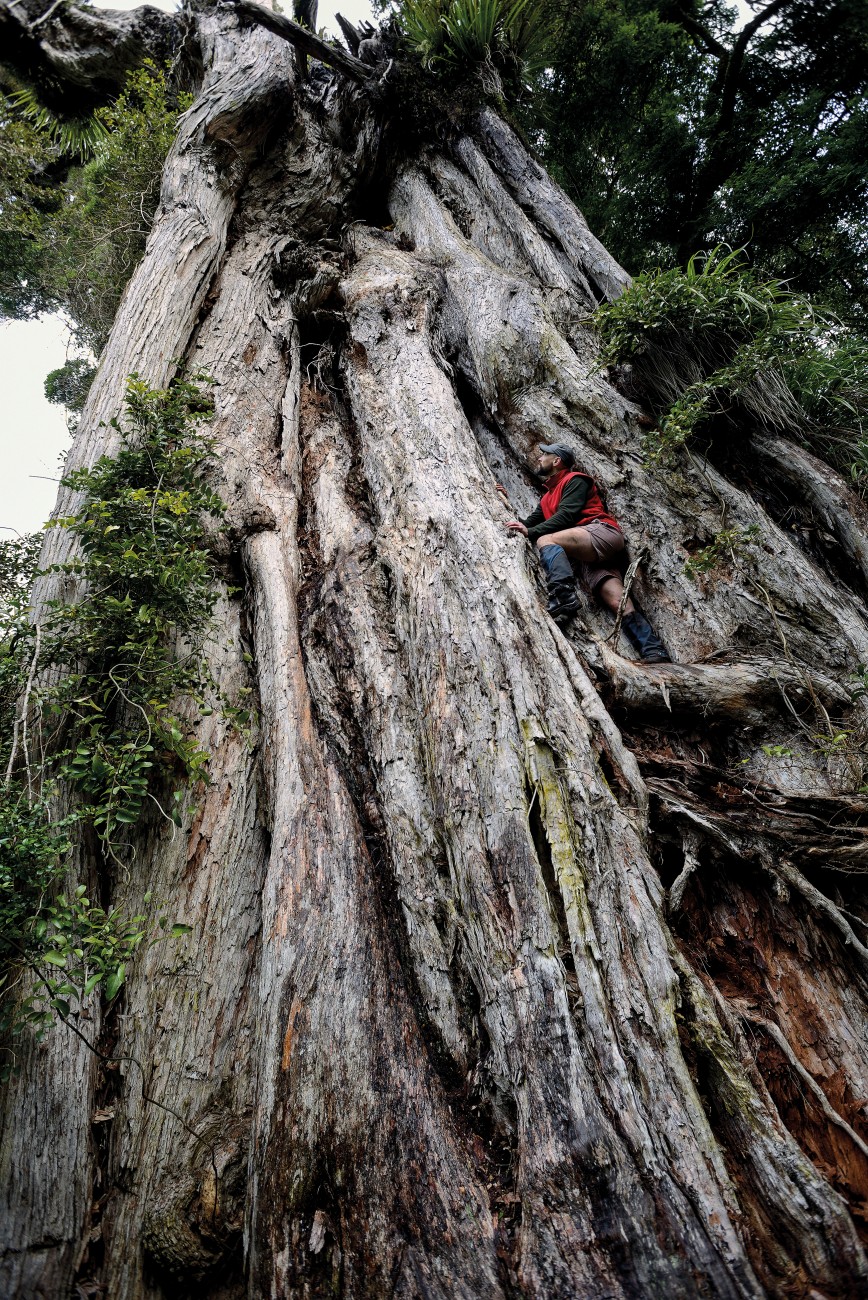
Islands in the sky
The forest canopy is home to all kinds of flora and fauna, some of which have only just been discovered. Canopy species are integral to soil health and climate regulation, but we don’t know exactly how, or why—and we’re in danger of losing them before we find out what’s at stake.

“We call it the last frontier of forest exploration,” says epiphyte ecologist Catherine Kirby. We’re off the track in Pureora Forest Park, and surrounding us are the trunks of rimu, kahikatea and tawa. This is one of the country’s last stands of thousand-year-old podocarps, and it brings to mind walking through the surviving columns of a Roman forum.
I gaze upwards towards the forest’s last frontier, but it’s too far away to see. Most life here takes place above our heads, beyond the ferns and saplings that screen the canopy from view.
Ahead there is a kahikatea trunk so slender that Kirby and I could almost encircle it with our arms. Three ropes lie slack against it; Kirby is attaching herself to one with the help of tree-climbing technician Andrew Harrison, who has already been up and down the second. The last one is for me.
Our destination is the top floor of the forest—the canopy. Walking here from Pureora Field Base, I tried to focus, for once, on looking up. I noticed that tawa hold tufts of long, dangling leaves in the crooks of their branches, like overstuffed baskets. These are nest epiphytes, or astelias, the sign of established life on high. Like the bromeliads of tropical rainforests, astelias capture water and plant detritus, which they turn into soil, creating hanging gardens above us. These in turn become home for reptiles, birds, invertebrates, bats, and other plants that will never set root in forest soil. Kōkako, kākāriki and kākā forage and feast here. So do possums and ship rats.

There’s little sign of this teeming life from far below, but a trained eye can find clues to what’s growing above. White petals scattered on the loam are signs of a clematis flowering 30 metres up, says Kirby.
Otherwise, it’s out of sight, out of mind. The canopy is one of the least visited, least researched and least understood ecosystems on Earth. As a human race, we’ve spent more time sending spacecraft to Mars than figuring out how this layer of the forest operates, especially in temperate zones such as New Zealand.
“It’s a big, fat, knowledge gap,” Kirby told me earlier. “You expect that 200 metres under the ocean, but actually we don’t really know that much about what’s just five metres above your head in the bush.”
Kirby knows more than most. She’s one of the few to have studied New Zealand’s epiphytes—plants that make their home in the sky, living harmlessly on top of other plants. Epiphytes don’t usually send roots into soil, nor do they tap into the veins of their hosts for food and water. They’re self-sufficient, collecting rainfall and photosynthesising. Some epiphytes, such as the northern rātā, send roots down to the soil, forming standalone trees once their host reaches the end of its lifespan—like a strangler fig, without the strangling—while mistletoes are hemi-epiphytic, plumbing into the water source of their hosts.
Though these plants are using others to get a leg up in life—literally—the canopy is crucial to soil health, climate regulation, the cycles of nutrients and water. “Imagine a forest as a jigsaw puzzle—it’s one of the pieces that makes it fit together and work,” says Kirby. We’re just not sure exactly how.
[Chapter Break]
Tree-climbing is a misnomer: what we’re climbing is a rope, a single line that Harrison has looped around the kahikatea’s upper branches. I’m suspended in a kind of cat’s cradle, with a loop of the rope to use as a stair. Push with your feet as you pull yourself up.
For the first 20 metres, there’s not much to look at except the slick trunk and the loamy floor a long way down. Then we reach the first few branches, and Kirby points out filmy ferns, sprays of tiny yellow orchids, a lancewood standing to attention. It isn’t uncommon to find trees germinating in the canopy—Kirby has spotted rimu taking root in the boughs of a tree, and Harrison once found a kauri growing out of the shattered crown of a larger kauri.
The forest changes shape from this perspective. Below me, ponga radiate outwards in giant pinwheels, like looking down at a crowd of inverted green umbrellas.
There’s a sound like someone shaking out a heavy rug—whumph, whumph—and I glance down just in time to see the rust-coloured wingspan of a kākā as it glides below us. We’ve heard them screeching all morning. There are kōkako in this forest, too—one of Kirby’s volunteers went missing for a morning following the siren call of one, trying to catch a glimpse of it, but never did.
Introduced plants might vastly outnumber native species, but up here, there are none to be found. “The cool thing about the canopy is that there are no weeds—no exotic epiphytes,” says Kirby. “If you’re up here looking at epiphytes, 99 per cent of the time they’re native species, and this is probably the only ecosystem like that. At the moment it’s quite pure, for want of a better word.”
The upper storey of the forest isn’t only difficult for humans to reach. “It’s a hard spot to grow in,” says Kirby. “Maybe we just don’t have the right weeds here yet.”
Kirby and I finally surface above the canopy, 30 metres up. It’s a windy day, and the tops of the trees toss and roll like waves. Emergent podocarp crowns surround us—a rimu behind us, a mataī on the other side, a stand of kahikatea further away.
We almost lost it all. In 1946, Pureora was the last forest to be opened for logging, but in 1978, protesters climbed trees as tall as this one and camped out in the canopy, bringing milling to a standstill.
[sidebar-1]
In the breeze, the tree trunks crack loudly—and somewhat disconcertingly—as they lean this way and that.
If the canopy is the surface of the ocean, then the epiphyte nests are islands floating on it. It’s a handy comparison in evolutionary terms, says Victoria University epiphyte ecologist Amanda Taylor, who studied how epiphyte species colonise various tree islands. Are there special relationships between certain epiphytes and host trees, or between epiphytes? Or are they all happy to settle down with others?
Epiphytes aren’t particular about who else is in the neighbourhood, Taylor found, but they do have a specific checklist when it comes to desirable real estate: horizontal branches that they won’t slip from, rough bark that seeds can adhere to. Rimu and hīnau are more popular than others. “Rimu has really nice near-90-degree-angle branches that make really good spots for nest epiphytes to flourish,” says Taylor. “And once they’re there, everyone can come and join the community.”
Taylor’s research project is only the second PhD to be completed in New Zealand on epiphyte communities. It’s been solitary work, she says. “You do feel like an explorer because hardly anyone is up there.”
The first person to pay attention to the canopy was the German botanist Andreas Schimper. His 1888 study of epiphyte ecology was based on observations made in the Americas, and for the next century, canopy research largely took place in the Tropics. “It’s only been in the last decade or so that epiphytes in southern temperate regions have started to become better studied,” says Taylor. “The epiphytes in New Zealand are very important habitat for our native fauna such as the New Zealand falcon and morepork, and also smaller critters—it should be a huge focus for conservation and restoration planning.”
Given that epiphytes arrive in a particular order, determining the sequence of colonisation could be the key to introducing epiphyte species to regenerating bush—a particular interest for Catherine Kirby.
“Sometimes restored bush is too far away from a natural bush block and it won’t get any epiphytes because their seeds and spores can’t travel that far,” she says. “There are particular plants that arrive on a tree first and facilitate the arrival of other plants. You can’t just glue one on to a tree.”
Part of the problem is a lack of humidity, especially in urban centres, as bush fragments can be too small to retain enough moisture for epiphyte growth.
Read backwards, Kirby’s and Taylor’s findings also offer a grim prediction: which species will be the first to go if—or when—the particular microclimates they have adjusted to are altered.
“Epiphytes are a good indicator for climate change,” says Taylor. “Because they’re so dependent on microclimate humidity, small changes in humidity can have a huge impact on their distribution. Such as ones that sit in montane regions of New Zealand that are usually shrouded by cloud—if that cloud was to lift, some species may not survive without the humidity.”
A few canopy-dwellers are prepared for dry spells. “Filmy ferns, also known as ‘resurrection plants’, will shrivel up in dry conditions,” she says. “When it rains, they rehydrate and resume their full size.”
We know how important epiphytes are to species diversity and ecosystem functioning, even if the details are foggy—they are a sign of a healthy forest, says Taylor. “They’re the last plants to colonise a forest. I remember one study which looked at forest recovery following a disturbance—they found that while trees are established after 50 years, it took 100 years for epiphytes to be established again.”
Younger, smaller trees don’t have the space for canopy communities to grow—another reason to suggest that protecting old forests is more beneficial than planting new ones.
A study of 673,046 trees on six continents published in 2014 found that tree growth accelerates with age, meaning that old trees can add the carbon-sink equivalent of an entire young tree annually in new growth.
Old trees—especially rimu, kāmahi, silver beech, southern rātā, and Hall’s tōtara—play a disproportionately significant role in the carbon cycle. It’s a narrative that doesn’t have a human parallel, as we’re so accustomed to the idea of declining productivity in later life—but in the forest, it’s the centenarians that are the star performers.
[Chapter Break]
Ark in the Park is so dense that its founder and custodian, John Sumich, has to carry secateurs and a machete to follow a path that was last walked just a couple of a months ago. This tear-drop-shaped ‘island’ in the Waitakere Ranges on Auckland’s west coast is intensively pest-controlled via a network of volunteers, and we’re replenishing a line of bait stations. As we scramble up and down, through dense patches of supplejack vines that scribble through all the available space between kānuka, nīkau and ponga, it’s impossible to glance up. When we pause to record bait quantities, I finally look around, spotting astelias encircling the trunks of nīkau palms as though they’re fur collars. In contrast to podocarp-broadleaf forests, some of them are low enough to touch.
The supplejack we’re fighting our way through produces berries that kōkako eat—kōkako that grew up in Pureora, in fact. “It’s a sort of joy walking through that forest,” says Sumich, tying a piece of pink marker ribbon to the frame of his glasses so that he doesn’t lose them if he sets them aside in the bush.
Here, climbing equipment donated by New Zealand Geographic a number of years ago is used to monitor 20 tracking tunnels placed in the canopy near large clumps of epiphytes. Bait is placed at the centre of an ink pad, with blank cardboard on either end. These have captured gecko tracks—which no one has yet spotted in the wild—as well as some surprisingly large rat footprints, says Auckland Zoo bird specialist Tanya Shennan.

Shennan volunteers for Ark in the Park through the zoo’s Conservation Fund, in order to keep an eye on its kōkako, but the fact that she’s trained to climb trees means she also monitors the tracking tunnels.
They’re useful for recording what the canopy community holds compared with what lives below. “One of their purposes is to gauge arboreal rat activity,” says Shennan. “It gives us a basis for amping up pest control, as well as picking up insects—wētā, cockroaches—you can identify their tiny, tiny footprints.”
Not all rat species are climbers, but the small, agile ship rat is particularly suited to life in the canopy. “Those lovely epiphyte clusters are really warm and cosy,” says Shennan. “If they’ve got access to food right up there, there’s not much reason for them to leave the canopy. They can tootle from tree to tree living off birds, reptiles and insects. A lot of the trees that we monitor, we do find rat activity.”
[Chapter Break]
Mustelids and ruminants take a multi-pronged approach to forests. Goats and deer strip the understorey; possums and their ilk devour the canopy and anything in it.
The effect on forests that don’t have predator control in place can clearly be seen in Northland. Where podocarps poke through the canopy of Russell Forest, they’re tree skeletons, stripped of leaves. This is difficult to see from ground level, but in May, Forest and Bird conservation advocate Dean Baigent-Mercer and his friend Toby Ricketts captured drone footage showing the bare crowns of tōtara, pūriri and northern rātā emerging from the canopy on Department of Conservation-managed land.
“They are ghost forests,” says Baigent-Mercer. “There’s a grey hue over the forest where it should be lush shades of green.”
Possums are fairly new to Northland: in April 1962, a series of sightings were enough of a novelty that they made the local newspaper. ‘Opossums are here now’, ran the Northern Age headline, which described the confusion of locals at finding them in their fruit trees. “So many people up here have stories about seeing their first possum,” says Baigent-Mercer. “There’s been a huge collapse in people’s lifetimes. I’ve met kaumātua who remember flocks of kākāriki and kākā.”

Possums are most famous as the foe of native birds, but they make short work of trees, too—they can kill a northern rātā in three years of vigorous eating. Meanwhile, kākāriki are now extinct north of Kawakawa, Massey University bird specialist Luis Ortiz-Catedral reported in November. It’s been a swift decline—around 25 years ago, kākāriki could be sighted from Cape Reinga to Paparoa, and a century ago, they were common enough—and annoying enough—that their extermination was sought and their feathers used to stuff mattresses.
Here, the solution is not scientific but political, says Baigent-Mercer. Less than 40 per cent of Department of Conservation-managed forest in Northland currently receives possum control, and Baigent-Mercer estimates that only two percent has multi-species predator control, largely thanks to community groups. The Ark in the Park model—which benefits from its proximity to Auckland in the form of its large volunteer workforce—isn’t a realistic option for forest restoration in more remote, less populous areas of the country. Greater central government funding is needed for pest control across the board, he says.

The good news is that it’s possible for trees that have been heavily browsed to recuperate, as Baigent-Mercer has found from observation on his own property in the Far North. “At my place in Otangaroa were these really huge, ancient pūriri trees that didn’t really have any leaves left on them. Slowly, over about five or six years of doing intensive possum control, they started re-sprouting young branches.”
[Chapter Break]
So what’s at stake? New Zealand has some of the most diverse epiphyte flora of any temperate forest, while around a quarter of the world’s invertebrate species are estimated to live in the canopy. In 2009, ecologist Kathrin Affeld captured a snapshot of the canopy’s extremely high biodiversity. She climbed 40 northern rātā in unlogged podocarp-broadleaf forest at Punakaiki and along the Heaphy Track on the West Coast, collecting more than 30 kilograms of epiphyte matter for dissection in the lab. Within the nests and clumps, she found 242,069 invertebrates, spanning 446 species, at least 10 of which were new to science and five recorded outside their known geographical range. In identifying them, she discovered three new genera. These nearly quarter of a million individuals—chewers, sap feeders, predators, scavengers, parasitoids and epiphyte grazers numbering higher than the population of Wellington—lived on epiphyte mats made of 157 different plant species.

Affeld was surprised to discover several arboreal ant colonies, the first known incidence of these species living in the canopy, while the variation in species from tree to tree—even from branch to branch within the same tree—astonished her. The canopy, she says, is a complex world in miniature, but it takes a while to get used to its tiny scale—and on a warm, calm day, the air traffic can be distracting.
“It was quite overwhelming how noisy and buzzy it was having all the insects around you. You just have to look closer, everything’s absolutely minute. There’s an entire world up there that is sort of connected to the ground, but unique in its own right. It was just mind-blowing, actually.”
Many of the invertebrates she found could barely be seen with the naked eye. “You think it doesn’t look like much, and then you look at it through the microscope.”
Her next surprise came in seeking to identify what she’d found. Relatively little is known about native New Zealand invertebrates—only around half of our arthropods have been described, and less than ten per cent of non-arthropod invertebrates. “In my case only 16 per cent of the collected specimens could be identified to species or morphospecies level—these were mostly beetles, wasps, moths and true bugs.”
Even fewer are understood ecologically. “It’s hard to pinpoint and quantify their role in pollination, nutrient cycling, the whole decomposition process. How much do they actually turn over? How widely are they dispersed?”
Although the role that canopy species play in soil health hasn’t been studied in New Zealand, international research has demonstrated that the canopy affects processes on the ground. “The nutrients that are intercepted in the canopy undergo changes so that by the time they have cycled through the system all the way down to the ground level, their composition and concentration have changed,” she says.

We don’t know how our invertebrates interact with each other and their environment, how they are distributed, and what role they play in the overall ecosystem—and finding out could help us identify vulnerabilities, to protect the canopy from the impact of introduced species, Affeld says.
Her research cites the destruction of invasive canopy invertebrates seen overseas, such as the yellow crazy ant, which substantially changed the composition of forests on Christmas Island north of Australia. “I did find some introduced invertebrates up in the canopy—beetles, thrips and flies,” she says. “How did they get up there? They were a long way from civilisation—it’s not like you get a whole lot of people climbing trees in the weekend that could introduce foreign organisms to the canopy.”
In a vicious circle, the lack of knowledge about canopy species dissuades others from studying them. And it’s difficult to predict research outcomes when a question mark hangs over so many species and processes.

But the blanks are slowly being filled in. A recent study found that a species of beech mistletoe, Peraxilla, has evolved a peculiar relationship with native birds, says Catherine Kirby. “It has these weird flowers where the petals are fused together. They have to have a tui, a bellbird, or a native bee snip the end of the petals off; they unfurl pretty quickly and that motion sprays pollen over the face of the bird or bee.”
Most of our species are generalists, says Kirby—but what specialist roles could other species play? What other unique or outrageous relationships or innovations could be acted out daily in the trees above our heads?
“That’s part of the intrigue, I suppose.”
[sidebar-2]

















